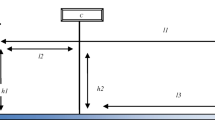Abstract
The paper presents an application of Hidden Markov Models (HMM) to fixations’ sequences analysis. The examination concerns eye tracking data gathered during performing simple comparison and decision tasks for four versions of plain control panels. The panels displayed the target and current velocity either on a digital or analog (clock-face) speedometers. Subjects were to decide whether increase or decrease the current speed by pressing the appropriate button. The obtained results suggest that females, generally exhibit different covert attention patterns than men. Moreover, the article demonstrates the estimated four HMM with three hidden states for every examined control panels variant and provides discussion of the outcomes.
Access this chapter
Tax calculation will be finalised at checkout
Purchases are for personal use only
Similar content being viewed by others
References
Akaike, H.: Information theory as an extension of the maximum likelihood theory. In: Petrov, B.N., Csaki, F. (eds.) Second International Symposium on Information Theory, pp. 267–281. Akademiai Kiado, Budapest (1973)
Baum, L.E.: An inequality and associated maximization technique in statistical estimation for probabilistic functions of Markov processes. In: Shisha, O. (ed.) Proceedings of the 3rd Symposium on Inequalities, University of California, Los Angeles, pp. 1–8 (1972)
Blatter, K., Graw, P., Munch, M., Knoblauch, V., Wirz-Justice, A., Cajochen, C.: Gender and age differences in psychomotor vigilance performance under differential sleep pressure conditions. Behav. Brain Res. 168(2), 312–317 (2006). doi:10.1016/j.bbr.2005.11.018
Chuk, T., Chan, A.B., Hsiao, J.H.: Understanding eye movements in face recognition using hidden Markov models. J. Vis. 14(11), 1–14 (2014). doi:10.1167/14.11.8
Courtemanche, F., Aïmeur, E., Dufresne, A., Najjar, M., Mpondo, F.: Activity recognition using eye-gaze movements and traditional interactions. Interact. Comput. 23(3), 202–213 (2011). doi:10.1016/j.intcom.2011.02.008
Ellis, S.R., Stark, L.: Statistical dependency in visual scanning. Hum. Factors J. Hum. Factors Ergon. Soc. 28(4), 421–438 (1986). doi:10.1177/001872088602800405
Eriksen, C.W., James, J.D.S.: Visual attention within and around the field of focal attention: a zoom lens model. Percept. Psychophys. 40(4), 225–240 (1986). doi:10.3758/BF03211502
Findlay, J.M., Gilchrist, I.D.: Active Vision. The Psychology of Looking and Seeing. Oxford University Press, New York (2003)
Haji-Abolhassani, A., Clark, J.J.: An inverse Yarbus process: predicting observers’ task from eye movement patterns. Vis. Res. 103, 127–142 (2014). doi:10.1016/j.visres.2014.08.014
Hayashi, M.: Hidden Markov Models to identify pilot instrument scanning and attention patterns. In: IEEE International Conference on Systems, Man and Cybernetics, 2003, vol. 3, pp. 2889–2896 (2003). doi:10.1109/ICSMC.2003.1244330
Liechty, J., Pieters, R., Wedel, M.: Global and local covert visual attention: Evidence from a bayesian hidden markov model. Psychometrika 68(4), 519–541 (2003). doi:10.1007/BF02295608
Michalski, R.: Information presentation compatibility in the simple digital control panel design—eye-tracking study. In: European Network Intelligence Conference—ENIC 2016, 5–7 September, Wroclaw, Poland (2016)
Murphy, K.: Hidden Markov Model (HMM) Toolbox for Matlab (1998, 2005). www.cs.ubc.ca/~murphyk/Software/HMM/hmm.html
Posner, M.I., Snyder, C.R., Davidson, B.J.: Attention and the detection of signals. J. Exp. Psychol. Gen. 109(2), 160–174 (1980). doi:10.1037/0096-3445.109.2.160
Rabiner, L.R.: A tutorial on hidden Markov models and selected applications in speech recognition. Proc. IEEE 77(2), 257–286 (1989). doi:10.1109/5.18626
Schwarz, G.: Estimating the dimension of a model. Ann. Stat. 6(2), 461–464 (1978). doi:10.1214/aos/1176344136
Simola, J., Salojärvi, J., Kojo, I.: Using hidden Markov model to uncover processing states from eye movements in information search tasks. Cogn. Syst. Res. 9(4), 237–251 (2008). doi:10.1016/j.cogsys.2008.01.002
Acknowledgments
The work was partially financially supported by Polish National Science Centre Grant No. 2011/03/B/ST8/06238. The eye tracking data were recorded by the system made available by the Laboratory of Information Systems Quality of Use which is a part of a BIBLIOTECH project cofounded by the European Union through the European Regional Development Fund under the Operational Programme Innovative Economy 2007–2013.
Author information
Authors and Affiliations
Corresponding author
Editor information
Editors and Affiliations
Rights and permissions
Copyright information
© 2017 Springer International Publishing AG
About this paper
Cite this paper
Grobelny, J., Michalski, R. (2017). Applying Hidden Markov Models to Visual Activity Analysis for Simple Digital Control Panel Operations. In: Świątek, J., Wilimowska, Z., Borzemski, L., Grzech, A. (eds) Information Systems Architecture and Technology: Proceedings of 37th International Conference on Information Systems Architecture and Technology – ISAT 2016 – Part III. Advances in Intelligent Systems and Computing, vol 523. Springer, Cham. https://doi.org/10.1007/978-3-319-46589-0_1
Download citation
DOI: https://doi.org/10.1007/978-3-319-46589-0_1
Published:
Publisher Name: Springer, Cham
Print ISBN: 978-3-319-46588-3
Online ISBN: 978-3-319-46589-0
eBook Packages: EngineeringEngineering (R0)




